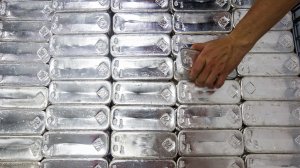TORONTO (miningweekly.com) – The global silver market saw record demand in 2015, driven by new highs in the jewellery, coin and bar, and photovoltaic (PV) sectors, which helped boost total silver demand to 1.17-billion ounces last year, according to a new report by market analysts at Thomson Reuters GFMS.
Its latest World Silver Survey 2016 reported that exceptional growth in these critical sectors had resulted in record-high demand during the year.
According to the report, the overall silver supply to the market was lower, led by the continued weakness in silver scrap sales. Last year’s supply and demand scenario led to the third consecutive yearly silver market deficit, reaching 129.8-million ounces, more than 60% larger than 2014 and the third largest on record.
GFMS stated that an extremely challenging year for nearly all commodities, along with a continued slowdown in Chinese economic growth and a stronger US dollar, led to a lower average silver price of $15.68/oz in 2015. However, analysts advised that this lower price environment had in fact helped boost physical demand, particularly as long-term investors viewed lower prices as key entry points, in expectation of future price appreciation.
Silver spot prices had appreciated 23% since the start of the year, to trade at $17.41/oz on Thursday.
METAL DEMAND
GFMS advised that, globally, silver jewellery fabrication increased for the third consecutive year to 226.5-million ounces. This increase was mainly attributable to a significant 16% rise from both India and Thailand, while North America posted a 5% yearly increase.
Analysts advised that these gains were partially offset by a sizeable contraction in Chinese jewellery offtake. Total silverware fabrication enjoyed its third successive yearly rise to an estimated 62.9-million ounces – a ten-year high.
The largest component of physical silver demand, industrial applications, which accounted for 50% of total physical silver demand last year, was 4% lower, totalling 588.7-million ounces. This drop was mainly attributed to weaker fabrication demand in developing countries and a stagnant global economy.
On a regional basis, modest increases in industrial demand were posted in the US and Japan, the second- and third-largest sources of industrial demand, respectively. GFMS advised that electrical and electronics use declined by 10% last year to 246.7-million ounces, owing to slower economic growth in developing countries and the continued weakness in computer sales.
Silver demand for PV applications rose 23% in 2015 to 77.6-million ounces, marking the second consecutive year of increases in this sector, driven by strong growth in Chinese solar panel installations.
Silver’s use in brazing alloys and solders fell by five-million ounces and photography demand slid by 4% last year. The pace of decline in photography slowed considerably, to its lowest rate since 2004, as digital technology in the photography industry approached maturity.
Meanwhile, identifiable investment demand, which included physical bar investment, coins and medals, as well as exchange-traded product build, climbed 16% to a near record high in 2015. Silver coin and bar investment surged 24% to reach 292.3-million ounces, the highest yearly demand level in GFMS’s records, overtaking the previous high in 2013.
SUPPLY TRENDS
GFMS stated that global silver mine production growth slowed to 2% in 2015 and reached a record 886.7-million ounces.
The mine production growth was attributable to stronger output in Peru, Argentina, Russia and India, while Canada, Australia and China had lower mine output, with China reducing output by 3%. Primary silver mine production grew 5%, and accounted for 30% of global silver mine supply. The overall slowdown in mine production last year was expected to continue.
GFMS analysts advised that primary silver co-product cash costs plus capital expenditures (capex) fell by 11% to $11.74/oz. This drop was driven by weaker local currencies, aggressively lower capex, and lower fuel prices. The producer silver hedge book grew by 7.8-million ounces in 2015, as fresh hedging more than offset maturing contracts, according to the report.
Scrap supply was significantly down by 13% at 146.1-million ounces, the lowest volume level recorded since 1992 and the fourth consecutive year of decline. Behind the decline were fewer collectors active in the market and some holding back material awaiting higher prices. Government sales of silver were again essentially nonexistent, analysts noted.
Edited by: Samantha Herbst
Creamer Media Deputy Editor
EMAIL THIS ARTICLE SAVE THIS ARTICLE
To subscribe email subscriptions@creamermedia.co.za or click here
To advertise email advertising@creamermedia.co.za or click here













